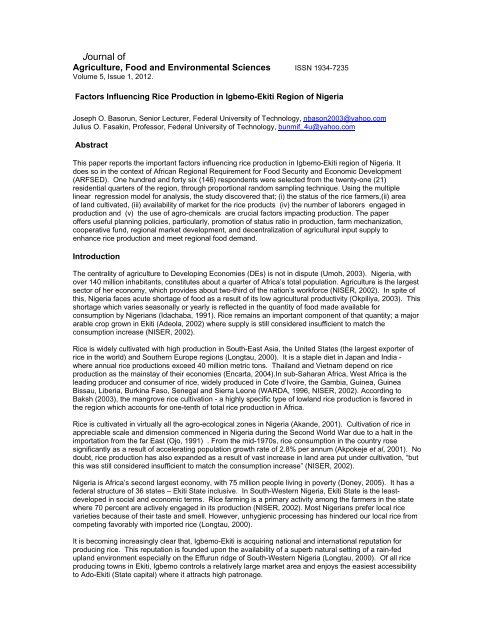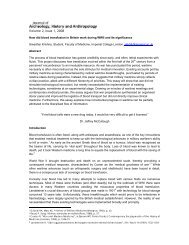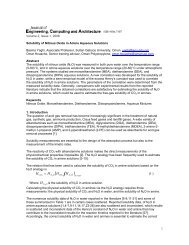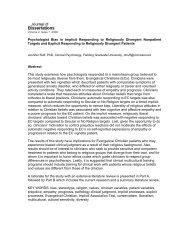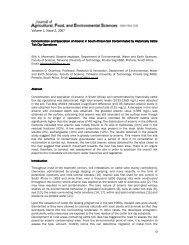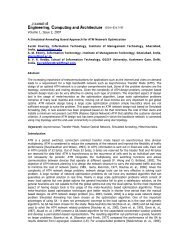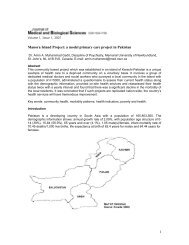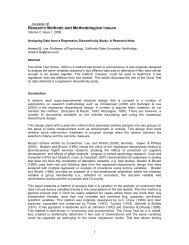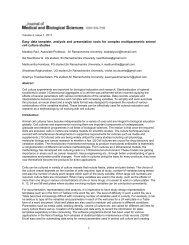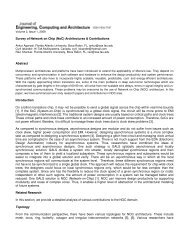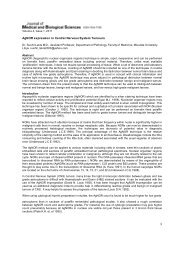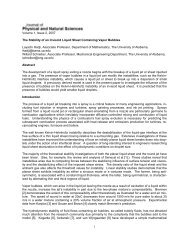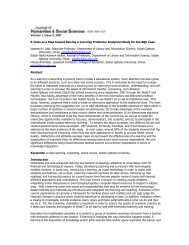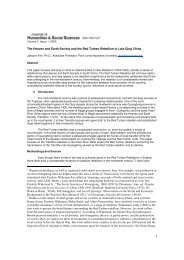Factors Influencing Rice Production in Igbemo-Ekiti Region of Nigeria
Factors Influencing Rice Production in Igbemo-Ekiti Region of Nigeria
Factors Influencing Rice Production in Igbemo-Ekiti Region of Nigeria
Create successful ePaper yourself
Turn your PDF publications into a flip-book with our unique Google optimized e-Paper software.
Journal <strong>of</strong><br />
Agriculture, Food and Environmental Sciences ISSN 1934-7235<br />
Volume 5, Issue 1, 2012.<br />
<strong>Factors</strong> <strong>Influenc<strong>in</strong>g</strong> <strong>Rice</strong> <strong>Production</strong> <strong>in</strong> <strong>Igbemo</strong>-<strong>Ekiti</strong> <strong>Region</strong> <strong>of</strong> <strong>Nigeria</strong><br />
Joseph O. Basorun, Senior Lecturer, Federal University <strong>of</strong> Technology, nbason2003@yahoo.com<br />
Julius O. Fasak<strong>in</strong>, Pr<strong>of</strong>essor, Federal University <strong>of</strong> Technology, bunmif_4u@yahoo.com<br />
Abstract<br />
This paper reports the important factors <strong>in</strong>fluenc<strong>in</strong>g rice production <strong>in</strong> <strong>Igbemo</strong>-<strong>Ekiti</strong> region <strong>of</strong> <strong>Nigeria</strong>. It<br />
does so <strong>in</strong> the context <strong>of</strong> African <strong>Region</strong>al Requirement for Food Security and Economic Development<br />
(ARFSED). One hundred and forty six (146) respondents were selected from the twenty-one (21)<br />
residential quarters <strong>of</strong> the region, through proportional random sampl<strong>in</strong>g technique. Us<strong>in</strong>g the multiple<br />
l<strong>in</strong>ear regression model for analysis, the study discovered that; (i) the status <strong>of</strong> the rice farmers,(ii) area<br />
<strong>of</strong> land cultivated, (iii) availability <strong>of</strong> market for the rice products (iv) the number <strong>of</strong> laborers engaged <strong>in</strong><br />
production and (v) the use <strong>of</strong> agro-chemicals are crucial factors impact<strong>in</strong>g production. The paper<br />
<strong>of</strong>fers useful plann<strong>in</strong>g policies, particularly, promotion <strong>of</strong> status ratio <strong>in</strong> production, farm mechanization,<br />
cooperative fund, regional market development, and decentralization <strong>of</strong> agricultural <strong>in</strong>put supply to<br />
enhance rice production and meet regional food demand.<br />
Introduction<br />
The centrality <strong>of</strong> agriculture to Develop<strong>in</strong>g Economies (DEs) is not <strong>in</strong> dispute (Umoh, 2003). <strong>Nigeria</strong>, with<br />
over 140 million <strong>in</strong>habitants, constitutes about a quarter <strong>of</strong> Africa’s total population. Agriculture is the largest<br />
sector <strong>of</strong> her economy, which provides about two-third <strong>of</strong> the nation’s workforce (NISER, 2002). In spite <strong>of</strong><br />
this, <strong>Nigeria</strong> faces acute shortage <strong>of</strong> food as a result <strong>of</strong> its low agricultural productivity (Okpiliya, 2003). This<br />
shortage which varies seasonally or yearly is reflected <strong>in</strong> the quantity <strong>of</strong> food made available for<br />
consumption by <strong>Nigeria</strong>ns (Idachaba, 1991). <strong>Rice</strong> rema<strong>in</strong>s an important component <strong>of</strong> that quantity; a major<br />
arable crop grown <strong>in</strong> <strong>Ekiti</strong> (Adeola, 2002) where supply is still considered <strong>in</strong>sufficient to match the<br />
consumption <strong>in</strong>crease (NISER, 2002).<br />
<strong>Rice</strong> is widely cultivated with high production <strong>in</strong> South-East Asia, the United States (the largest exporter <strong>of</strong><br />
rice <strong>in</strong> the world) and Southern Europe regions (Longtau, 2000). It is a staple diet <strong>in</strong> Japan and India -<br />
where annual rice productions exceed 40 million metric tons. Thailand and Vietnam depend on rice<br />
production as the ma<strong>in</strong>stay <strong>of</strong> their economies (Encarta, 2004).In sub-Saharan Africa, West Africa is the<br />
lead<strong>in</strong>g producer and consumer <strong>of</strong> rice, widely produced <strong>in</strong> Cote d’Ivoire, the Gambia, Gu<strong>in</strong>ea, Gu<strong>in</strong>ea<br />
Bissau, Liberia, Burk<strong>in</strong>a Faso, Senegal and Sierra Leone (WARDA, 1996, NISER, 2002). Accord<strong>in</strong>g to<br />
Baksh (2003), the mangrove rice cultivation - a highly specific type <strong>of</strong> lowland rice production is favored <strong>in</strong><br />
the region which accounts for one-tenth <strong>of</strong> total rice production <strong>in</strong> Africa.<br />
<strong>Rice</strong> is cultivated <strong>in</strong> virtually all the agro-ecological zones <strong>in</strong> <strong>Nigeria</strong> (Akande, 2001). Cultivation <strong>of</strong> rice <strong>in</strong><br />
appreciable scale and dimension commenced <strong>in</strong> <strong>Nigeria</strong> dur<strong>in</strong>g the Second World War due to a halt <strong>in</strong> the<br />
importation from the far East (Ojo, 1991) . From the mid-1970s, rice consumption <strong>in</strong> the country rose<br />
significantly as a result <strong>of</strong> accelerat<strong>in</strong>g population growth rate <strong>of</strong> 2.8% per annum (Akpokeje et al, 2001). No<br />
doubt, rice production has also expanded as a result <strong>of</strong> vast <strong>in</strong>crease <strong>in</strong> land area put under cultivation, “but<br />
this was still considered <strong>in</strong>sufficient to match the consumption <strong>in</strong>crease” (NISER, 2002).<br />
<strong>Nigeria</strong> is Africa’s second largest economy, with 75 million people liv<strong>in</strong>g <strong>in</strong> poverty (Doney, 2005). It has a<br />
federal structure <strong>of</strong> 36 states – <strong>Ekiti</strong> State <strong>in</strong>clusive. In South-Western <strong>Nigeria</strong>, <strong>Ekiti</strong> State is the leastdeveloped<br />
<strong>in</strong> social and economic terms. <strong>Rice</strong> farm<strong>in</strong>g is a primary activity among the farmers <strong>in</strong> the state<br />
where 70 percent are actively engaged <strong>in</strong> its production (NISER, 2002). Most <strong>Nigeria</strong>ns prefer local rice<br />
varieties because <strong>of</strong> their taste and smell. However, unhygienic process<strong>in</strong>g has h<strong>in</strong>dered our local rice from<br />
compet<strong>in</strong>g favorably with imported rice (Longtau, 2000).<br />
It is becom<strong>in</strong>g <strong>in</strong>creas<strong>in</strong>gly clear that, <strong>Igbemo</strong>-<strong>Ekiti</strong> is acquir<strong>in</strong>g national and <strong>in</strong>ternational reputation for<br />
produc<strong>in</strong>g rice. This reputation is founded upon the availability <strong>of</strong> a superb natural sett<strong>in</strong>g <strong>of</strong> a ra<strong>in</strong>-fed<br />
upland environment especially on the Effurun ridge <strong>of</strong> South-Western <strong>Nigeria</strong> (Longtau, 2000). Of all rice<br />
produc<strong>in</strong>g towns <strong>in</strong> <strong>Ekiti</strong>, <strong>Igbemo</strong> controls a relatively large market area and enjoys the easiest accessibility<br />
to Ado-<strong>Ekiti</strong> (State capital) where it attracts high patronage.
<strong>Igbemo</strong> locates between longitude 5 o 23’ and 5 o 24’ East <strong>of</strong> the Greenwich Meridian and latitude 7 o 41’ and<br />
7 o 42’ North <strong>of</strong> the Equator (Appendix). It lies with<strong>in</strong> an upland zone ris<strong>in</strong>g over 250 meters above sea level.<br />
Politically, it situates with<strong>in</strong> Irepodun – Ifelodun Local Government Area (LGA) and <strong>Ekiti</strong> Central Senatorial<br />
District <strong>of</strong> <strong>Ekiti</strong> State. <strong>Igbemo</strong> town has, <strong>in</strong> recent years, experienced a progressive <strong>in</strong>crease <strong>in</strong> population<br />
due to natural <strong>in</strong>crease and immigration from other towns. The <strong>of</strong>ficial population record <strong>in</strong> 1991, ranked<br />
<strong>Igbemo</strong> third (with a population <strong>of</strong> 15,739) <strong>of</strong> the eleven (11) major settlements <strong>in</strong> the Local Government<br />
Area, after Igede (24,607) and Iy<strong>in</strong> (25,931). The projection to the year 2005 by the Department <strong>of</strong><br />
Population Activities, Cab<strong>in</strong>et and Special Service, Office <strong>of</strong> the <strong>Ekiti</strong> State Governor, Ado-<strong>Ekiti</strong> puts <strong>Igbemo</strong><br />
<strong>in</strong> the third position (23,024) after Igede (35,996) and Iy<strong>in</strong> (37,931) out <strong>of</strong> total projected population figure <strong>of</strong><br />
161,286 for the entire Local Government Area.<br />
Objectives <strong>of</strong> the study<br />
This paper aims at look<strong>in</strong>g <strong>in</strong>to the key factors propell<strong>in</strong>g rice production us<strong>in</strong>g data sourced from <strong>Igbemo</strong><br />
agropolitan <strong>Region</strong> <strong>in</strong> <strong>Ekiti</strong> state <strong>of</strong> <strong>Nigeria</strong>. The objectives <strong>of</strong> study, therefore, are to:<br />
1. exam<strong>in</strong>e the rice farmers’ pr<strong>of</strong>ile <strong>in</strong> <strong>Igbemo</strong>-<strong>Ekiti</strong> region <strong>of</strong> <strong>Nigeria</strong>;<br />
2. identify and analyze the basic factors controll<strong>in</strong>g rice farm<strong>in</strong>g generally <strong>in</strong> the region, and;<br />
3. propose management measures to enhance rice production <strong>in</strong> the study area.<br />
Review <strong>of</strong> Literature<br />
This study adopts essentially the concept <strong>of</strong> a regional ‘agropole’. It was developed to provide deductive<br />
explanations for the importance <strong>of</strong> a centre <strong>in</strong> an agricultural region. It is predicated on the ideals <strong>of</strong><br />
economic welfare <strong>of</strong> a region subject to a dom<strong>in</strong>ant agricultural activity. It is co<strong>in</strong>ed from the term “growth<br />
pole” which implies; a centre with some <strong>in</strong>dicators <strong>of</strong> growth (Perroux, 1955), a geographic agglomeration <strong>of</strong><br />
activities (Boudeville, 1966) and <strong>in</strong>deed, the centre <strong>of</strong> an activity whose productive capacity <strong>in</strong>fluences the<br />
performance <strong>of</strong> other activities <strong>in</strong> a particular economy (Ivarah, 2003). A basic tenet <strong>of</strong> this concept is the<br />
build<strong>in</strong>g up <strong>of</strong> a system that l<strong>in</strong>ks a process <strong>of</strong> activities to human communities <strong>in</strong> a regional sett<strong>in</strong>g.<br />
<strong>Region</strong>al agropole <strong>in</strong> this study refers to a major agricultural area. It describes the evolutionary and physical<br />
agricultural attributes which an established settlement possesses that reflect some features <strong>of</strong> central place<br />
<strong>in</strong> a geographical context. In this case, the focus is ma<strong>in</strong>ly on a particular growth-<strong>in</strong>duc<strong>in</strong>g activity <strong>in</strong> a<br />
place. The major factor <strong>in</strong>fluenc<strong>in</strong>g structural regional differentiation with a dom<strong>in</strong>ant pole is the presence <strong>of</strong><br />
a propulsive <strong>in</strong>dustry (Omuta and Onorkerhoraye, 1986). This <strong>in</strong>dustry is usually characterized by three<br />
important features; (i) high <strong>in</strong>teraction with other firms; (ii) a high degree <strong>of</strong> <strong>in</strong>fluence, and (iii) great size<br />
(Darwent, 1975). Industries possess<strong>in</strong>g these three attributes are normally characterized by output data<br />
higher than the average that affect other <strong>in</strong>dustries and the total output <strong>of</strong> the economy (Sule, 2000).<br />
Presently, <strong>Igbemo</strong> is a centre <strong>of</strong> attraction to most <strong>Ekiti</strong> <strong>in</strong>digenes that trade on rice. In the region, are smallscale<br />
rice process<strong>in</strong>g activities which promote commerce <strong>in</strong> <strong>Ekiti</strong> State. Increas<strong>in</strong>gly, entrepreneurial<br />
activities at this centre are becom<strong>in</strong>g generators <strong>of</strong> productive forces, relationships and growth. Over time,<br />
<strong>Igbemo</strong> is poised to become a powerful centre <strong>of</strong> change, transmitt<strong>in</strong>g developmental impulses to the<br />
immediate Local Government Areas and <strong>Ekiti</strong> State <strong>in</strong> general.<br />
Methods<br />
Database and Participants<br />
A structured questionnaire was adm<strong>in</strong>istered to the household heads. A proportional random selection <strong>of</strong><br />
146 respondents from the exist<strong>in</strong>g residential quarters (compounds) conterm<strong>in</strong>ous with the Independent<br />
National Electoral Commission (INEC) political wards <strong>in</strong> the town was adopted. The sample was<br />
disaggregated <strong>in</strong>to twenty seven (27) quarters accord<strong>in</strong>g to the numbers <strong>of</strong> build<strong>in</strong>gs used as proxy<br />
population for farmers’ population <strong>in</strong> each. Thereafter, samples were randomly chosen from the wards<br />
which represent well-def<strong>in</strong>ed Data Del<strong>in</strong>eation Areas (DDAs). In a house, one household head <strong>of</strong> age 18<br />
and above was <strong>in</strong>terviewed.<br />
2
Fig.1: <strong>Igbemo</strong> <strong>in</strong> the national sett<strong>in</strong>g<br />
Source: <strong>Ekiti</strong> State M<strong>in</strong>istry <strong>of</strong> Urban and Physical Plann<strong>in</strong>g<br />
Out <strong>of</strong> the 146 respondents with<strong>in</strong> <strong>Igbemo</strong>, 127 (87.0 percent) were farmers, <strong>of</strong> which 108 (74.0 percent)<br />
specialized on rice production. Subsequent analysis focused on this group (rice farmers) as the targeted<br />
population. The variables employed <strong>in</strong> the analysis were; status <strong>of</strong> the farmer (STATUS), motivat<strong>in</strong>g factor<br />
for rice farm<strong>in</strong>g (MOTIVE), area <strong>of</strong> land cultivated (AREA); laborer engaged <strong>in</strong> farm<strong>in</strong>g (LABOR), use <strong>of</strong><br />
agrochemicals (AGRO), <strong>in</strong>stitutional assistance (ASSIST) and the possible market for the rice product<br />
(MARKET). These variables were selected because <strong>of</strong> their likelihood to impact harvest annually.<br />
Cross-sectional data were collected from sampled rice farmers with the aid <strong>of</strong> <strong>in</strong>terview schedule which<br />
was found to be very appropriate because, majority <strong>of</strong> the farmers were illiterates. The data generated<br />
were subjected to analysis us<strong>in</strong>g descriptive statistics such as frequency counts, percentages and mean,<br />
and regression analysis to determ<strong>in</strong>e the resource use efficiency <strong>of</strong> rice farmers <strong>in</strong> the area<br />
3
Table 1: Def<strong>in</strong>ition <strong>of</strong> Research Variables<br />
S/N Variable Def<strong>in</strong>ition <strong>of</strong> Variable Measurement Scale Mean<br />
Code<br />
1. HARVEST Average Annual Harvest 1 =< 400Kg,<br />
2= 401-800Kg<br />
3 = 801 - 1200Kg,<br />
4= 1201-1600Kg<br />
5 = 1601-2000Kg,<br />
6= >2000Kg<br />
2. STATUS Marital Status <strong>of</strong> Respondent 1 = Widowed<br />
2 = Divorced<br />
3 = S<strong>in</strong>gle<br />
4 = Married<br />
3 MOTIVE Motivat<strong>in</strong>g Factor for 1 = Parent / Inheritance<br />
<strong>Rice</strong> Farm<strong>in</strong>g<br />
2= Lucrativeness<br />
3 = Environment (soil and<br />
Climate)<br />
4 = Lack <strong>of</strong> Education<br />
4 AREA Annual Land Area (acres) 1 = under 10 acres<br />
Cultivated<br />
2= 11-20acres<br />
3 = 21- 30 acres<br />
4= 31- 40 acres<br />
5= 41– 50 acres<br />
6 = 51 -60 acres<br />
7 = 61-70 acres<br />
8 = 71- 80 acres<br />
9 = 81- 90 acres<br />
10 = 91 – 100 acres (1hc)<br />
11 = > 1 hectare.<br />
5. LABOR Number <strong>of</strong> laborers<br />
Engaged on the farm<br />
1 = 1- 2people<br />
2 = 3 – 4 people<br />
3 = 5 – 6 people<br />
4 = 7 – 8 people<br />
5 = 9 – 10 people<br />
6 = 10 people and above<br />
6. AGRO Agrochemicals used 1 = Fungicide<br />
2 = pesticide<br />
3 = Herbicide<br />
4 = Fertilizer<br />
7. ASSIST Form <strong>of</strong> Assistance on 1 = Credit facility (loan)<br />
<strong>Rice</strong> Farm<strong>in</strong>g<br />
2 = Equipment/tractor<br />
3 = Free Labor<br />
4 = Seeds<br />
5 = Agrochemicals<br />
6 = Tra<strong>in</strong><strong>in</strong>g,<br />
7 = None<br />
8. MARKET Market for <strong>Rice</strong> Product 1 = Inefficient<br />
2 = Fairly efficient<br />
3 = Just efficient<br />
4 = Very efficient.<br />
Source: Authors’ Computation, 2010<br />
4<br />
960kg<br />
3.80<br />
1.87<br />
< 10acres<br />
2.82<br />
3.64<br />
6.23<br />
3.82
Table 1 shows that a farmer produces 960kg on average per annum. This is low due to the crude method <strong>of</strong><br />
farm<strong>in</strong>g. Aga<strong>in</strong>, families are <strong>in</strong>volved <strong>in</strong> production more than <strong>in</strong>dividuals, although as noted earlier,<br />
<strong>in</strong>dividualization <strong>of</strong> hold<strong>in</strong>gs is on the <strong>in</strong>crease. The ma<strong>in</strong> reason for rice production rema<strong>in</strong>s the probable<br />
pr<strong>of</strong>it – a common factor with economic man. An abysmally less than 10 acres are cultivated annually by<br />
each farmer – a factor that may be responsible for the low production level earlier stated. M<strong>in</strong>imal<br />
mechanization and chemical application may also be responsible. The predom<strong>in</strong>at<strong>in</strong>g chemical application is<br />
fertilizer, the most popular among <strong>Nigeria</strong>n farmers <strong>in</strong> general. Farmers see the market outlets as efficient<br />
because it absorbs production output from them.<br />
Rational for Inclusion <strong>of</strong> Variables<br />
Obviously, <strong>Nigeria</strong> faces acute food shortage as a result <strong>of</strong> its low agricultural productivity (Okpiliya, 2003,<br />
Basorun, 2008). This shortage is peculiar to rice which is a staple food. Subair (2008), <strong>in</strong> highlight<strong>in</strong>g the<br />
comment <strong>of</strong> the Special Adviser to <strong>Nigeria</strong>n President and the Head <strong>of</strong> New Partnership for African<br />
Development (NEPAD), remarks that “<strong>Nigeria</strong> spends N100 billion (£454.5m) on rice importation annually”.<br />
This prompts <strong>in</strong>vestigation <strong>in</strong>to average annual harvest (HARVEST) <strong>of</strong> the farmers <strong>in</strong> the selected agropole.<br />
In this context, the marital status (STATUS) <strong>of</strong> the producers is significant to determ<strong>in</strong>e labor requirements.<br />
Motivat<strong>in</strong>g factor <strong>in</strong>to rice production (MOTIVE) is a major attribute that will expla<strong>in</strong> the <strong>in</strong>terest <strong>of</strong> the farmer<br />
<strong>in</strong> the job. The total area cultivated (AREA) is significant to rice availability <strong>in</strong> meet<strong>in</strong>g consumers’ demands.<br />
As observed, ‘farmers <strong>in</strong> sub-Saharan Africa are handicapped by lack <strong>of</strong> timely and sufficient access to<br />
<strong>in</strong>puts, credit and appropriate technology among other th<strong>in</strong>gs’ (P<strong>in</strong>strup-Anderson, 2001). The number <strong>of</strong><br />
laborers engaged <strong>in</strong> cultivation (LABOR), the type <strong>of</strong> agrochemical used (AGRO), assistance by <strong>in</strong>stitutions<br />
(ASSIST) and possible market for the product (MARKET) have been chosen to analyze these critical factors<br />
which are required to accelerate the rice farm<strong>in</strong>g process and capacity strengthen<strong>in</strong>g at the agropole.<br />
Calibration <strong>of</strong> Model <strong>of</strong> Analysis<br />
Harvest, is the dependent variable <strong>of</strong> analysis <strong>in</strong> this study which is used as a proxy for the level <strong>of</strong><br />
productivity <strong>of</strong> the farmers. A vector <strong>of</strong> other parameters <strong>of</strong> model estimation can be gleaned from table 1.<br />
The simple l<strong>in</strong>ear regression model is chosen with the mathematical format stated below:<br />
Y = a + b 1 X 1 + b 2 X 2<br />
……… b j Xj + e ………….………… (i)<br />
Where Y = dependent variable, a = the <strong>in</strong>tercept value <strong>of</strong> the regression hyperplane, b 1 - b j = the partial<br />
regression coefficients, X 1 - X J = the explanatory variables and e = error term.<br />
The choice <strong>of</strong> this model lies <strong>in</strong> its ability to show the partial strength and possibly test the significance <strong>of</strong> the<br />
parameters <strong>of</strong> estimat<strong>in</strong>g rice farmers’ level <strong>of</strong> production <strong>in</strong> the study area. Although, this model has its<br />
territorial limits, it has been found to be very efficient <strong>in</strong> predict<strong>in</strong>g parameters that affect the behavior <strong>of</strong> a<br />
given phenomenon. Willis (1991) employed the regression model <strong>in</strong> determ<strong>in</strong><strong>in</strong>g overcrowd<strong>in</strong>g and house<br />
conditions <strong>in</strong> the Ghanaian hous<strong>in</strong>g market. Sanusi and Salimonu (2006) adopted the same model to<br />
assess the relationship between selected factors <strong>in</strong>puts and <strong>in</strong>come from yam production extension <strong>in</strong> Oyo<br />
State, <strong>Nigeria</strong>. The goal <strong>of</strong> the present study is to determ<strong>in</strong>e factors that impact rice production <strong>in</strong> <strong>Igbemo</strong>-<br />
<strong>Ekiti</strong>, <strong>Nigeria</strong>. The motivation is to see if the model that had been used <strong>in</strong> various contexts can yield<br />
comparable results <strong>in</strong> a different socio-economic context <strong>of</strong> <strong>Igbemo</strong> region.<br />
Results<br />
Objective 1: Exam<strong>in</strong><strong>in</strong>g the <strong>Rice</strong> Farmer’s Pr<strong>of</strong>ile <strong>in</strong> <strong>Igbemo</strong>-<strong>Ekiti</strong> <strong>Region</strong> <strong>of</strong> <strong>Nigeria</strong><br />
F<strong>in</strong>d<strong>in</strong>gs show that out <strong>of</strong> the 87.0% that are farmers, 74.0% grow rice, confirm<strong>in</strong>g the agrarian status <strong>of</strong> <strong>Ekiti</strong><br />
State. The farmers are predom<strong>in</strong>antly male (66.6%). Majority (40.7%) are illiterates, who earn less than 550<br />
dollars per annum. Half <strong>of</strong> the farmers are <strong>of</strong> middle age (45-50yrs) who have been <strong>in</strong> the job for more than<br />
10 years. Although rice farm<strong>in</strong>g seems to be the ma<strong>in</strong> agricultural occupation, an average farmer cultivates<br />
less than 10 acres annually. Many <strong>of</strong> the respondents (77.6%) cultivate rice because it is lucrative. Manual<br />
method <strong>of</strong> tillage is adopted while surpris<strong>in</strong>gly 86.0% make use <strong>of</strong> agrochemicals. The farmers depend on<br />
local varieties to which they apply much chemicals with little yield. Virtually all (93.5%) <strong>of</strong> them hardly enjoy<br />
<strong>in</strong>stitutional assistance, hence, the basic barrier to rice farm<strong>in</strong>g <strong>in</strong> the region rema<strong>in</strong>s fund<strong>in</strong>g (90.7%).<br />
5
Objective 2: Identification and Analysis <strong>of</strong> the basic factors controll<strong>in</strong>g <strong>Rice</strong> farm<strong>in</strong>g<br />
generally <strong>in</strong> the region.<br />
Before model calibration, all these variables were correlated to ascerta<strong>in</strong> degree <strong>of</strong> l<strong>in</strong>earity between them<br />
and determ<strong>in</strong>e the <strong>in</strong>dependence <strong>of</strong> the regression factors. From table 2 (Appendix), motivat<strong>in</strong>g factor for<br />
rice production (MOTIVE) has the highest correlation <strong>of</strong> 0.770 with the use <strong>of</strong> labor (LABOR), followed by<br />
0.748 between annual harvests (HARVEST) and status <strong>of</strong> the rice farmer (STATUS). Land area used for<br />
cultivation (AREA) shows least relationship (0.048) with assistance to farmers (ASSIST).<br />
Table 2: Correlation Matrix <strong>of</strong> <strong>Rice</strong> Farmers’ Variables <strong>in</strong> <strong>Igbemo</strong>-<strong>Ekiti</strong><br />
Variable code HARVEST STATUS MOTIVE AREA LABOR AGRO ASSIST MARKET<br />
HARVEST<br />
p-value<br />
1.000 0.748**<br />
0.000<br />
0.679**<br />
0.000<br />
0.555**<br />
0.000<br />
0.648**<br />
0.000<br />
0.718**<br />
0.000<br />
0.417**<br />
0.000<br />
0.490**<br />
0.000<br />
STATUS<br />
p-value<br />
1.000 0.433<br />
0.000<br />
0.377**<br />
0.000<br />
0.633**<br />
0.000<br />
0.622**<br />
0.000<br />
0.130<br />
0.125<br />
0.185*<br />
0.027<br />
MOTIVE<br />
p-value<br />
1.000 0.599**<br />
0.000<br />
0.770**<br />
0.000<br />
0.449**<br />
0.000<br />
0.318**<br />
0.000<br />
0.372**<br />
0.000<br />
AREA<br />
p-value<br />
1.000 0.442**<br />
0.000<br />
0.602**<br />
0.000<br />
0.048<br />
0.572<br />
0.070<br />
0.409<br />
LABOR<br />
p-value<br />
1.000 0.662**<br />
0.000<br />
0.397**<br />
0.000<br />
0.488**<br />
0.000<br />
AGRO<br />
p-value<br />
1.000 0.084<br />
0.327<br />
0.120<br />
0.155<br />
ASSIST<br />
p-value<br />
1.000 0.733**<br />
0.000<br />
MARKET 1.000<br />
*Correlation is significant at the 0.5 level (2-tailed)<br />
** Correlation is significant at the 0.01 level (2-tailed)<br />
Source: Authors’ fieldwork, 2010<br />
Table 3: Stepwise Variable Selection for <strong>Rice</strong> Farmers’ Harvest <strong>in</strong> <strong>Igbemo</strong> - <strong>Ekiti</strong><br />
Unstandardized<br />
Coefficients<br />
Standardized<br />
Coefficients<br />
B Std. Error Beta<br />
T<br />
Sig.<br />
Model<br />
1. (Constant)<br />
STATUS<br />
11.097<br />
1.135<br />
0.868<br />
0.067 0.816<br />
12.780<br />
16.851<br />
.000<br />
.000<br />
2. (Constant)<br />
STATUS<br />
AREA<br />
8.367<br />
1.076<br />
2.938<br />
0.882<br />
0.060<br />
0.464<br />
0.774<br />
0.275<br />
9.491<br />
17.830<br />
6.330<br />
.000<br />
.000<br />
.000<br />
3. (Constant)<br />
STATUS<br />
AREA<br />
MARKET<br />
-9.739<br />
0.982<br />
2.892<br />
4.915<br />
3.695<br />
0.059<br />
0.429<br />
0.978<br />
0.706<br />
0.271<br />
0.211<br />
-2.636<br />
16.694<br />
6.746<br />
5.024<br />
.009<br />
.000<br />
.000<br />
.000<br />
4. (Constant)<br />
STATUS<br />
AREA<br />
MARKET<br />
LABOR<br />
-17.345<br />
0.893<br />
2.855<br />
3.930<br />
2.189<br />
4.520<br />
0.066<br />
0.419<br />
1.018<br />
0.784<br />
0.643<br />
0.267<br />
0.168<br />
0.139<br />
-3.837<br />
13.606<br />
6.815<br />
3.858<br />
2.793<br />
.000<br />
.000<br />
.000<br />
.000<br />
.006<br />
5. (Constant)<br />
STATUS<br />
AREA<br />
MARKET<br />
LABOR<br />
AGRO<br />
-21.290<br />
0.735<br />
2.130<br />
4.176<br />
2.526<br />
3.223<br />
Dependent Variable = HARVEST<br />
Source: Authors’ Computation, 2010<br />
4.543<br />
0.080<br />
0.464<br />
0.989<br />
0.766<br />
0.999<br />
0.529<br />
0.199<br />
0.179<br />
0.161<br />
0.177<br />
-4.687<br />
9.179<br />
4.595<br />
4.224<br />
3.299<br />
3.225<br />
000<br />
.000<br />
.000<br />
.000<br />
.000<br />
.002<br />
6
From table 3, only five (5) <strong>of</strong> the variables (STATUS, AREA, MARKET, LABOR and AGRO) impact<br />
significantly, the quantity <strong>of</strong> rice harvested annually by farmers <strong>in</strong> <strong>Igbemo</strong>. These variables were <strong>in</strong>troduced<br />
step-wise <strong>in</strong>to the model to obta<strong>in</strong> the best regression equation (Appendix, Table 3). The equation <strong>of</strong> best<br />
regression apply<strong>in</strong>g the least square algorithm is <strong>in</strong> the form <strong>of</strong>:<br />
Y = -21.290+0.735(STATUS) +2.130 (AREA) + 4.176 (MARKET)+ 2.526 (LABOR) + 3.223 (AGRO)….. (ii)<br />
The variable, STATUS, is the most significant variable expla<strong>in</strong><strong>in</strong>g rice farmers’ harvest. HARVEST will<br />
<strong>in</strong>crease by 52.9%, if the numbers <strong>of</strong> married people who engage <strong>in</strong> rice farm<strong>in</strong>g are doubled. The table also<br />
<strong>in</strong>dicates an <strong>in</strong>crease <strong>in</strong> HARVEST by 19.9% as the farmer <strong>in</strong>creases his farm size by 100%. Though<br />
significant, this <strong>in</strong>crease is small, obviously due to crude use <strong>of</strong> implements with little mechanization<br />
(Fakorede, 2001).<br />
The market<strong>in</strong>g possibility for the product (MARKET) shows a coefficient estimate <strong>of</strong> 0.179, <strong>in</strong>dicat<strong>in</strong>g a rise<br />
<strong>in</strong> harvest by 17.97% if the present rate <strong>of</strong> demand for rice <strong>in</strong>creases by 100%. Obviously, the supply is low<br />
<strong>in</strong> response to <strong>in</strong>crease <strong>in</strong> demand; despite the fact that 95.4% have access to good market<strong>in</strong>g centre. The<br />
impact <strong>of</strong> LABOR on HARVEST has been found to be positive. Should the farmer double the present<br />
number <strong>of</strong> laborers used <strong>in</strong> cultivation, <strong>in</strong>crease <strong>in</strong> annual harvest by 16.1% will occur. Majority <strong>of</strong> the<br />
farmers (98.1%) rely heavily on manual labor with five to six laborers engaged <strong>in</strong> bush clear<strong>in</strong>g, weed<strong>in</strong>g <strong>of</strong><br />
rice farm, plant<strong>in</strong>g, harvest<strong>in</strong>g and bird scar<strong>in</strong>g. Further analysis reveals a possible <strong>in</strong>crease <strong>in</strong> HARVEST by<br />
17.7% if the use <strong>of</strong> agrochemicals is doubled. In the region, the common farm<strong>in</strong>g practice is shift<strong>in</strong>g<br />
cultivation that depletes the soil rapidly.<br />
Objective 3: Propos<strong>in</strong>g Management Measures to enhance <strong>Rice</strong> production <strong>in</strong> the study<br />
area<br />
Specifically, factors requir<strong>in</strong>g serious policy attention <strong>in</strong>clude: status <strong>of</strong> the rice farmers, area <strong>of</strong> land put<br />
under rice cultivation, market<strong>in</strong>g <strong>of</strong> the local rice, labor engagement <strong>in</strong> cultivation, and use <strong>of</strong> agrochemicals.<br />
F<strong>in</strong>d<strong>in</strong>gs reveal that productivity is small <strong>in</strong> relation to the marital status <strong>of</strong> the respondents due to <strong>in</strong>creas<strong>in</strong>g<br />
<strong>in</strong>dividualization <strong>of</strong> farm hold<strong>in</strong>gs. A State District Development Commission (SDDC) should as a matter <strong>of</strong><br />
urgency <strong>in</strong>tervene decisively to tra<strong>in</strong> farmers to use both improved seedl<strong>in</strong>gs and farm mechanization. The<br />
SDDC can collaborate with International Institute <strong>of</strong> Tropical Agriculture (IITA) <strong>in</strong> this regard.<br />
With regards to farm size, adequate education on mechanization will encourage utilization <strong>of</strong> modern farm<br />
implements for plough<strong>in</strong>g, plant<strong>in</strong>g, weed<strong>in</strong>g and harvest<strong>in</strong>g at subsidized cost, thus, reduc<strong>in</strong>g the high cost<br />
<strong>of</strong> labor <strong>in</strong>put. The constra<strong>in</strong>t <strong>of</strong> capital, no doubt, limits productivity <strong>of</strong> these farmers, especially with the<br />
contract –farm<strong>in</strong>g arrangement. A paradigm shift from this unpr<strong>of</strong>itable approach to ‘Cooperative Fund’ (CF)<br />
is advocated to empower the farmers to restructure their enterprises f<strong>in</strong>anc<strong>in</strong>g. The SDDC can organize this<br />
with organized farmers’ groups for the purpose <strong>of</strong> <strong>in</strong>vest<strong>in</strong>g on rice farm<strong>in</strong>g project with a shar<strong>in</strong>g formula on<br />
proceeds.<br />
In a further effort <strong>of</strong> the SDDC to strengthen the market<strong>in</strong>g <strong>in</strong>frastructure and organization for greater<br />
efficiency and effectiveness, a new <strong>Region</strong>al Market Development (RMD) strategy is proposed to widen the<br />
market for <strong>Igbemo</strong> rice. This strategy will promote the establishment <strong>of</strong> new modern markets and the<br />
expansion <strong>of</strong> exist<strong>in</strong>g ones. Already, the market at the State capital (Ado-<strong>Ekiti</strong>) records the highest<br />
patronage by the local rice marketers. The new regional market will be established <strong>in</strong> <strong>Igbemo</strong> as modern<br />
major market with<strong>in</strong> the framework <strong>of</strong> regional communities surround<strong>in</strong>g the town.<br />
It is evident that the rice farmers <strong>in</strong> <strong>Igbemo</strong> use agrochemicals substantially. No doubt, these farmers will<br />
prefer a location where cost <strong>of</strong> receiv<strong>in</strong>g the material is at a m<strong>in</strong>imum. On this note, there is the need for a<br />
decentralized approach to the Agricultural Input Supply (AIS) policy <strong>of</strong> government <strong>in</strong> the State. The<br />
framework envisages the establishment <strong>of</strong> Centre for Agricultural Input Supply (CAIS) through the SDDC <strong>in</strong><br />
<strong>Igbemo</strong>. To complement this effort, the SDDC can partner with private organizations to establish a manure<br />
factory, under a well organized government waste-to-manure program to <strong>in</strong>crease the production <strong>of</strong> soil<br />
manure required for high productivity.<br />
Discussions<br />
S<strong>in</strong>gle factor analysis shows the prevalence <strong>of</strong> married farmers (88.0%). This result is due to the large<br />
household size <strong>of</strong> respondents that allows more farm<strong>in</strong>g hands which naturally leads to <strong>in</strong>creased<br />
productivity (Basorun, 2008). The <strong>Ekiti</strong> State Agricultural Development Project (ESADP) was established “to<br />
expose farmers to improved agricultural technology made up <strong>of</strong> improved seeds, fertilizers, pesticides and<br />
farm mechanization aids” (Alao and Olujimi, 1992). About 93.5% <strong>of</strong> the farmers claimed not to have enjoyed<br />
7
any <strong>in</strong>stitutional assistance. Consequently, it is plausible that a little <strong>in</strong>crease will result from a doubl<strong>in</strong>g <strong>of</strong><br />
farm sizes.<br />
<strong>Igbemo</strong> region may be noted for concerted rice production, yet the level <strong>of</strong> production cannot meet the<br />
demand <strong>of</strong> the people. Part <strong>of</strong> the problems is the extreme seasonality <strong>of</strong> rice availability due to limited<br />
storage facilities. Quite ironically, rice farm<strong>in</strong>g has ceased to be a family bus<strong>in</strong>ess as more people now have<br />
their separate farms due to shortage <strong>of</strong> family hands (NISER, 2002). At the crucial stages (plant<strong>in</strong>g,<br />
weed<strong>in</strong>g and harvest<strong>in</strong>g) many <strong>of</strong> the farmers enter <strong>in</strong>to contract–farm<strong>in</strong>g arrangements by us<strong>in</strong>g rice<br />
harvested to pay the laborers, thus, lead<strong>in</strong>g to a reduced level <strong>of</strong> rice <strong>of</strong>fered for market<strong>in</strong>g to the public. The<br />
limited <strong>in</strong>crease <strong>in</strong> yield is not also unconnected with the local unimproved variety <strong>of</strong> rice cultivated that<br />
responds very little to fertilizer and herbicide application.<br />
Conclusion<br />
A number <strong>of</strong> resources abound <strong>in</strong> different regions <strong>of</strong> <strong>Nigeria</strong> that could be effectively harnessed for regional<br />
development. Many <strong>of</strong> these have been left untapped. In effect, the poor region has to exhibit low <strong>in</strong>come,<br />
unemployment and poor quality <strong>of</strong> life. <strong>Ekiti</strong> is a new state with relatively low federal allocation and <strong>in</strong>ternally<br />
generated revenue when compared with the old state and those <strong>in</strong> the oil produc<strong>in</strong>g regions <strong>of</strong> the country.<br />
However, it is a notable rice produc<strong>in</strong>g region – an economic potential that could be used to elevate its level<br />
<strong>of</strong> development.<br />
This study has identified some major factors impact<strong>in</strong>g rice production <strong>in</strong> an important rice production centre<br />
(<strong>Igbemo</strong>) <strong>in</strong> <strong>Ekiti</strong> state <strong>of</strong> <strong>Nigeria</strong>. The analytical framework for the study has proved efficacious <strong>in</strong> identify<strong>in</strong>g<br />
those variables that <strong>in</strong>fluence HARVEST <strong>in</strong> the agrarian community. The f<strong>in</strong>d<strong>in</strong>gs call for policies capable <strong>of</strong><br />
enhanc<strong>in</strong>g rice production <strong>in</strong> the area through a new regional development framework that emphasizes<br />
decentralization <strong>of</strong> current regional development policies while advocat<strong>in</strong>g for a State District Development<br />
Commission (SDDC) and a change <strong>of</strong> orientation <strong>in</strong> the marketers’ mode <strong>of</strong> operations. The policy<br />
discussions and recommendations however, hold some promises for <strong>Ekiti</strong> State and <strong>Nigeria</strong> as a whole.<br />
References:<br />
Adeola, C. (2002). Analysis <strong>of</strong> Economic Efficiency <strong>of</strong> Male and Female <strong>Rice</strong> Farmers <strong>in</strong> <strong>Ekiti</strong> State,<br />
<strong>Nigeria</strong>, NISER Monograph Series 15, 2002.<br />
Akande, T. (2001). An Overview <strong>of</strong> the <strong>Nigeria</strong>n <strong>Rice</strong> Economy, Research paper published by the <strong>Nigeria</strong>n<br />
Institute <strong>of</strong> Social and Economic Research (NISER), Ibadan, 11pp.<br />
Akpokodje, G., Lancon, F and Ere<strong>in</strong>ste<strong>in</strong>, O. (2001). <strong>Nigeria</strong>’s <strong>Rice</strong> Economy: State <strong>of</strong> the Art, Draft Report,<br />
WARDA-NISER Collaborative Study.<br />
Alao, K. and Olujimi, J.A.B. (1992). Rural Development Efforts <strong>in</strong> Ondo State <strong>Nigeria</strong>, - A case study <strong>of</strong><br />
Directorate <strong>of</strong> Food, Road and Rural Infrastructure (DFRR), an Unpublished Research Report 199p.<br />
Baksh, D. (2003). The Right Way to Process <strong>Rice</strong>. Journal <strong>of</strong> African Farm<strong>in</strong>g, September/October Edition,<br />
26.<br />
Basorun, J. O., (2008). Susta<strong>in</strong>able Strategies for Strengthen<strong>in</strong>g a <strong>Region</strong>al Agropole: A Case <strong>of</strong><br />
<strong>Igbemo</strong>-<strong>Ekiti</strong>, <strong>Nigeria</strong>, Ph.D Thesis, Federal University <strong>of</strong> Technology, Akure, <strong>Nigeria</strong>.<br />
Boudeville, J.R. (1966). Problems <strong>of</strong> <strong>Region</strong>al Economic Plann<strong>in</strong>g, Ed<strong>in</strong>burgh, Ed<strong>in</strong>burgh University press.<br />
Darwent, D. (1975). Growth Po<strong>in</strong>ts and Centres <strong>in</strong> <strong>Region</strong>al Plann<strong>in</strong>g: <strong>in</strong> Friedmann and Alonso (eds),<br />
<strong>Region</strong>al Policy Read<strong>in</strong>gs <strong>in</strong> Theory and Applications, Massachusetts, Mit Press, 540.<br />
Donney, M. (2005). <strong>Nigeria</strong> by Numbers, Development 32, 9.<br />
Encarta Premium Suite (2004). Plant<strong>in</strong>g <strong>Rice</strong>, Retrieved June 15, 2006<br />
Fakorede, M.A.B. (2001). Revolutionaliz<strong>in</strong>g <strong>Nigeria</strong>n Agriculture with the Golden Seed, Inaugural Lecture,<br />
Obafemi Awolowo University, Ile-Ife.<br />
Idachaba, F. (1991). The Nature <strong>of</strong> the <strong>Nigeria</strong>n Food Problem. Journal <strong>of</strong> Agricultural Science, 1 (1): 6<br />
Ivarah, J.B. (2003). <strong>Region</strong>al Plann<strong>in</strong>g, Ben<strong>in</strong> City Tide Publishers.<br />
8
Longtau, S.R. (2000). Multi-Agency Partnership <strong>in</strong> West African Agriculture: A Review and Description <strong>of</strong><br />
<strong>Rice</strong> <strong>Production</strong> System <strong>in</strong> <strong>Nigeria</strong>, Monograph, published by Eco-system Development Organization,<br />
Jos. 47 pp.<br />
NISER (2002). Assessment <strong>of</strong> the Economic, Social and Environmental Impacts <strong>of</strong> <strong>Rice</strong> <strong>Production</strong> <strong>in</strong><br />
<strong>Nigeria</strong> with the Trade Liberation Framework, A Research paper 93 pp.<br />
Ojo, M.O. (1991). Food Policy and Economic Development <strong>in</strong> <strong>Nigeria</strong>, Lagos, Design <strong>Production</strong> <strong>Nigeria</strong><br />
Limited.<br />
Okpiliya, F.I. (2003). Variation <strong>of</strong> <strong>Rice</strong> Yield with Temperature and Ra<strong>in</strong>fall at Ogoja, <strong>Nigeria</strong>. Journal <strong>of</strong><br />
Agricultural Sciences 2(2): 98 – 101.<br />
Omuta, G.E.D and Onokerhoraye, A.G. (1986). <strong>Region</strong>al Development and Plann<strong>in</strong>g, Ben<strong>in</strong>, Eguavoen<br />
Pr<strong>in</strong>ters, 10.<br />
Perroux, F. (1955). Economic space: Theory and Applications, Quarterly Review <strong>of</strong> Economic 1 (4): 64-89.<br />
Sanusi, W.A. and Salimonu, K.K. (2005). Food Security among Households: Evidence from Yam<br />
<strong>Production</strong> Economics <strong>in</strong> Oyo State, <strong>Nigeria</strong>, Agricultural Journal 1(4): 249-253.<br />
Subair, Gbola (2008 November 25). <strong>Nigeria</strong> Spends N100 billion Yearly to Import <strong>Rice</strong>, <strong>Nigeria</strong> Tribune, 3.<br />
Sule, O. (2000). Paradigms <strong>of</strong> <strong>Region</strong>al Development Plann<strong>in</strong>g <strong>in</strong> Africa: Theory and Practice, Calabar,<br />
Prathel (Nig) Enterprises, 40.<br />
Umoh, G.S. (2003). <strong>Nigeria</strong>: Macroeconomic Environment and the Perennial Crops, Global Journal <strong>of</strong><br />
Agricultural Science, 2(1): 53 – 61.<br />
West Africa <strong>Rice</strong> Development Association – WARDA (1996). <strong>Rice</strong> Trends <strong>in</strong> Sub-Sahara Africa, Second<br />
edition, WARDA, Bouake.<br />
Willis, K.G.; (1991). “Regression Analysis: Determ<strong>in</strong>ants <strong>of</strong> Overcrowd<strong>in</strong>g and House Conditions <strong>in</strong><br />
Ghanaian Hous<strong>in</strong>g Market” <strong>in</strong> Pepple, A.G. and Willis, K.G. (eds) Hous<strong>in</strong>g <strong>in</strong> the Develop<strong>in</strong>g World:<br />
Methods <strong>of</strong> Analysis, Case Studies and Policies, London, Routledge.<br />
Acknowledgement:<br />
The authors thank the Federal University <strong>of</strong> Technology, Akure, <strong>Nigeria</strong> for provid<strong>in</strong>g the grant for<br />
the Ph.D research by the correspond<strong>in</strong>g author on which this article is based.<br />
9


